The Evolution and Impact of Skater Sneakers
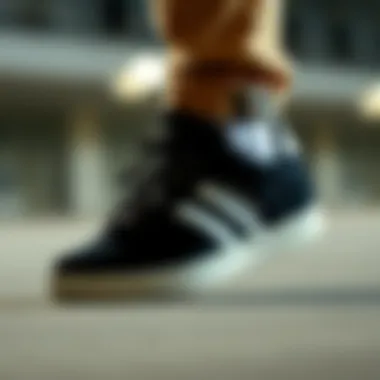
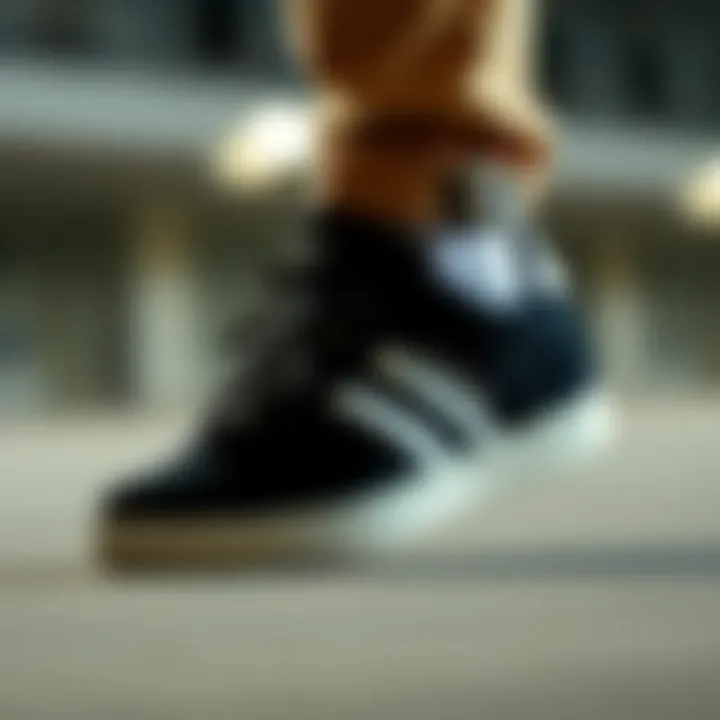
Intro
In the heart of skateboarding culture lies a dynamic relationship between skater sneakers and the thrill of the ride. Initially designed just for functionality, these specialized shoes have blossomed into a vibrant symbol of personal style, individuality, and culture. Delving into their evolution provides a glimpse not only into the world of skateboarding but also into how fashion intertwines with practicality.
From their humble beginnings in the 1970s to the present day, skater sneakers have transformed as much as the skateboarding community itself. Today, they do more than just protect feet; they communicate identity. Each scuff, every crease, tells a story of countless sessions at the local park or daring attempts on the half-pipe. This article will explore how skater sneakers have evolved through different eras, highlighting key innovations and the brands that championed their development.
"The right pair of shoes can transform how you skate, giving you confidence in your tricks and style."
Skater sneakers do a balancing act, staking their claim at the intersection of function and fashion. While their foundational purpose revolves around durability and grip, they've also become trendy, influencing streetwear and even mainstream fashion.
Let’s unravel this fascinating journey, examining how skater sneakers have shaped not just the way skaters perform but also how they express themselves in a culture steeped in creativity and rebellion.
Understanding Skater Sneakers
Skater sneakers play an essential role in both the performance and identity of skateboarding culture. They are not just shoes; they are tools of the trade for skaters, designed to withstand the rigors of the skate park while allowing for optimal performance. This section will delve into the driving factors that have shaped skater sneakers and underline their importance in the transformation of skateboarding into a prominent cultural phenomenon.
Definition and Purpose
In the simplest terms, skater sneakers are shoes designed specifically for skateboarding. They offer critical features like grip, support, and durability, tailored to the unique demands of the sport. But beyond surface definitions, these sneakers represent a lifestyle for many. They symbolize an individual's freedom, creativity, and rebellion, reflecting the core values of skateboarding itself.
Their purpose extends far beyond just functionality. They serve as an expression of personal style and identity, with various designs that resonate with diverse segments of the skateboarding community. Whether it’s the bright colors preferred by younger skaters or the minimalist designs favored by street skaters, the purpose of skater sneakers encompasses both performance and personal statement.
Evolution of Design
Over the years, the design of skater sneakers has evolved significantly, following the convergence of usability and style in an ever-changing cultural landscape. Initially, they were purely functional footwear catering to skaters' needs. However, as skateboarding gained popularity and began intersecting with fashion, sneakers evolved into a vibrant cultural artifact.
From Functional Footwear to Fashion Statement
Originally designed for grip and resilience, skater sneakers transitioned into iconic fashion items as skateboarding permeated mainstream culture. The 1980s saw a surge of graphic designs and bold color combinations, reflecting the edgy spirit of skate culture. The switch from merely functional shoes to stylish fashion statements marked a pivotal moment, merging athletic performance with aesthetic appeal.
The biggest draw of this evolution was the unique designs that made a statement yet didn’t sacrifice functionality. Brands started to experiment with materials like suede and canvas, enhancing both durability and style. This shift made skater sneakers popular not just on the board but also on city streets, showing how they catered to both skaters and fashion-conscious consumers alike.
Influence of Skateboarding Styles on Sneaker Design
The styles and tricks associated with various skateboarding techniques have directly influenced sneaker design. Each skating style, whether it’s street, vert, or freestyle, has its distinct requirements that shape shoe features. For instance, street skating often necessitates a flatter sole for better boardfeel, resulting in sneakers that prioritize ground contact and control.
Moreover, pro skater endorsements have an undeniable impact on design. Each professional has a unique approach to skating, leading sneaker brands to innovate functionalities that align with specific demands. Thus, designs evolve not only based on aesthetic trends but also in response to feedback and requirements from the skateboarding community, ensuring that the sneakers live up to the demands of different styles.
In summary, understanding skater sneakers involves recognizing their dual role as both performance tools and cultural symbols. The interplay of evolving design and the diverse needs of skaters has helped solidify their place within skateboarding culture, making them a vital topic in any conversation about skateboarding's history and future.
Historical Context
Understanding the historical context surrounding skater sneakers is crucial for grasping their evolution and cultural significance. This backdrop provides insights into not just the development of skateboarding as a sport but also how the community's identity has shaped sneaker design and trends over time. The shifts in consumer demand, the emergence of iconic brands, and the influence of street culture all contribute to a rich tapestry that defines skater sneakers today.
Origins of Skateboard Footwear
Initial Market Offerings
In the early days of skateboarding, sneakers were simply what was available. The initial footwear market wasn't tailored to the specific needs of skaters. Typically, it consisted of basic athletic shoes that offered little in the way of support or grip. One notable offering was the thick-soled canvas shoes which gained traction due to their low cost and accessibility.
These early options had a unique feature: they were often lightweight, allowing for easy maneuverability on the board. However, this came with several drawbacks. The lack of durability meant that they would wear out quickly, especially under the high-impact nature of skateboarding. Nonetheless, their availability catered to budget-conscious skaters who were just stepping into the sport. The grassroots recognition of these shoes eventually led to more specialized designs.
Key Players in the Early Years
As skateboarding gained popularity, certain brands began to emerge as the frontrunners in the footwear market. Vans and Converse took the lead, with their iconic styles resonating with the youth culture of the time. Vans introduced the Authentic model, a simple yet effective choice that became a staple among skaters for its grip and board feel.
These brands became fundamental because of their commitment to the skating community. They often supported local skaters and events, creating a bond that transcended mere commerce. However, the downside was that while they started focusing on performance, many still struggled to incorporate fashion into their designs. This approach worked for some but left room for others to innovate and create more fashionable yet functional footwear.
Cultural Shifts Throughout the Decades
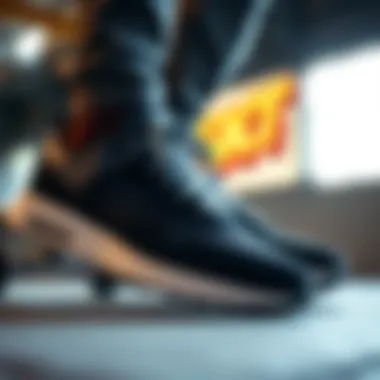
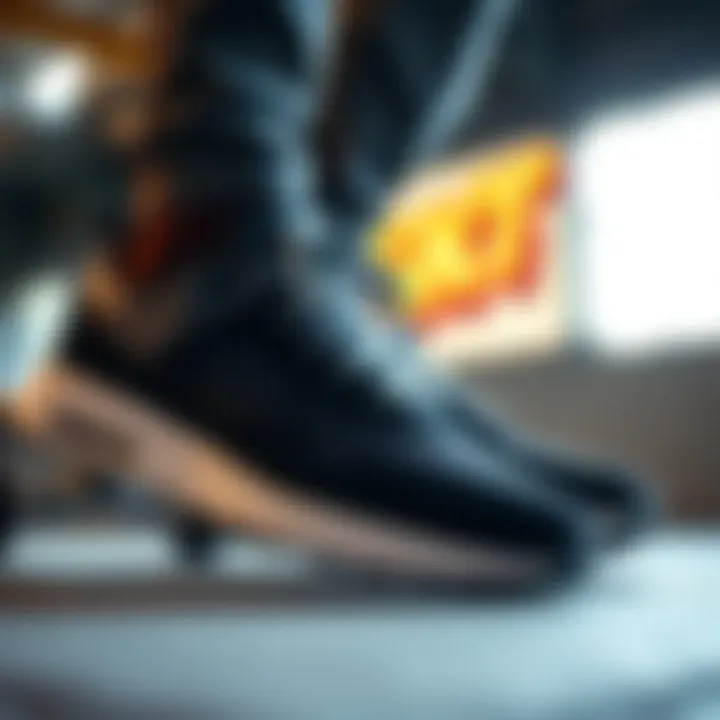
1980s: The Birth of Skate Culture
The 1980s marked a pivotal time, bringing about the birth of skateboard culture as we understand it today. The rise of skateboarding as a mainstream activity was accompanied by a newfound sense of identity among skaters, leading to the demand for specialized footwear. Brands that recognized this shift began to evolve their designs to include better materials and cushioning technology. This decade saw the introduction of high-top sneakers, which offered additional ankle support—this was especially appealing as more tricks emerged in the skate scene.
Moreover, the popularity of skate videos helped to elevate the visibility of iconic skaters, bringing their shoe choices into the limelight. Each impressive trick performed in particular styles of shoes helped solidify their status as more than just a means of protection; they became symbols of identity and community pride.
1990s: The Rise of Brand Collaborations
As we entered the 1990s, the synergy between skateboarding and fashion intensified with the rise of brand collaborations. This was a game-changer for the skater sneaker scene. Brands started aligning with professional skaters to develop signature lines, capitalizing on their influence and style. For instance, the collaboration between Nike SB and various well-known skateboarders created sneakers that merged high performance with trendy aesthetic. These collaborations didn't just cater to functionality; they became collector's items, sought after by enthusiasts and casual skaters alike.
By the late ’90s, skater sneakers evolved into a fashion statement, embodying a broader lifestyle. However, this led to some criticism within the core community, where some purists felt that the essence of skate culture was being diluted by mainstream marketing tactics. Yet, this period undeniably fostered a deeper connection between skateboarding and broader youth culture—making sneakers a vital accessory that expressed individuality through design.
Key Features of Skater Sneakers
Skater sneakers are not just a trend; they serve practical and cultural purposes in the skateboarding community. The right pair isn’t merely a fashion statement; it enhances performance, provides comfort, and ensure safety. Understanding the key features of these sneakers is vital for skaters and enthusiasts alike, as it can significantly impact one’s performance on the board and their overall experience within skateboarding culture.
Materials and Construction
Durability Considerations
When you think about skateboarding, durability is front and center. The constant wear and tear from the board flips, grinds, and slides can tear apart footwear if they aren’t robust enough. That's where the materials used in construction step in. Skater sneakers typically boast features like reinforced seams and durable fabrics like suede or leather.
These materials are crucial; they not only withstand the day-to-day mishaps but also extend the lifespan of the sneakers. For instance, sneakers made from vulcanized rubber soles usually provide extra grip, making them a popular choice among skaters. The added life and performance they bring ensure that skaters can focus more on perfecting their flourishes rather than worrying about the state of their shoes. The downside, however, is sometimes a heavier weight, which might not appeal to everyone.
Breathability and Comfort
Let's talk about another cornerstone: breathability and comfort. Skating is no walk in the park. It's a physically demanding activity, and having that comfort cushion in your footwear is non-negotiable. A sneaker should feel like an extension of your feet, nimble yet supportive.
Typically, brands incorporate mesh panels or perforations in key areas to keep air flowing. This not only helps in keeping things cool but also prevents that infamous skater's foot odor. The comfort factor comes from elements like padded collars and insoles. However, the balance sometimes comes at a slight cost. Highly breathable sneakers might sacrifice some sturdiness. So, skaters often have to weigh options based on their skating style or climate.
Grip and Performance
Outsole Technology
Now, let's move to the part that connects us to the board—outsole technology. The right outsole can mean the difference between mastering that trick or eating dirt on a tough landing. Many modern skater sneakers feature advanced outsole designs that provide an extraordinary grip. Textured surfaces and specialized rubber compounds can greatly enhance performance on different terrains.
Brands design the outsole depending on skating styles, which may lead to choices like a flat sole for board feel or a cushioned one for impact absorption. A solid grippy outsole allows skaters to ride confidently, knowing they won’t face slippage when they're trying to stick a landing. Yet, there’s a trade-off; soft rubber soles wear out quicker than harder compounds, requiring skaters to change their shoes more frequently.
Impact Protection Features
Skating can be brutal on the body, so impact protection is crucial. Certain sneakers incorporate physics-based features like gel cushioning and custom midsoles designed to absorb shocks from jumps or falls. This can be especially helpful when trying out bigger tricks or riding on elevated surfaces.
While the presence of impact protection features can make a sneaker less light-weight, the reassurance of knowing your feet are shielded from high-impact landings usually outweighs that. It’s a key characteristic that many skaters search for when deciding on their gear, especially for those who are serious about pushing their limits.
"Great sneakers can make a skater feel more in tune with their board, turning every ride into a dance of balance and freedom."
Popular Skater Sneaker Brands
The landscape of skater sneakers is predominantly shaped by brands that not only contribute to the footwear industry but also intertwine with the very culture of skateboarding. Popular skater sneaker brands, like Vans and Nike SB, are significant to this article because they represent more than just shoes; they symbolize identity, community, and a unique blend of fashion and function. Understanding these brands allows readers to appreciate how skater culture evolves alongside their favorite footwear.
Vans: A Staple in Skate Culture
Vans has been a cornerstone of skateboard culture since its inception in the 1960s. Known for their durable designs, it's not just sport; it's about lifestyle. From humble beginnings to global recognition, Vans embodies the spirit of skateboarding like no other brand.
Iconic Models and Their Legacy
The legacy of Vans is encapsulated in models like the Old Skool and the Slip-On. Originating in California, these shoes became synonymous with skater culture, praised for their sturdy construction and simplistic yet effective designs. The Old Skool features the classic side stripe, while the Slip-On is famed for its easy wear, making it a favored choice among skaters seeking comfort without sacrificing style.
- Key Characteristic: Their retro aesthetic appeals broadly—people don them both on the streets and at skate parks.
- Contribution to the Topic: These models not only serve practical needs but also make a bold statement about a skater's style and affiliation within the community.
However, one can argue that such popularity comes with drawbacks. The widespread usage of popular models can sometimes dilute their exclusivity, making it a balancing act for companies like Vans who aim to stay true to their roots while reaching expansive audiences.
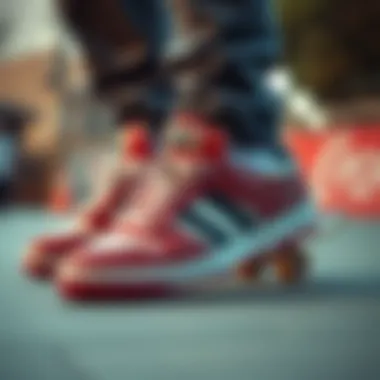
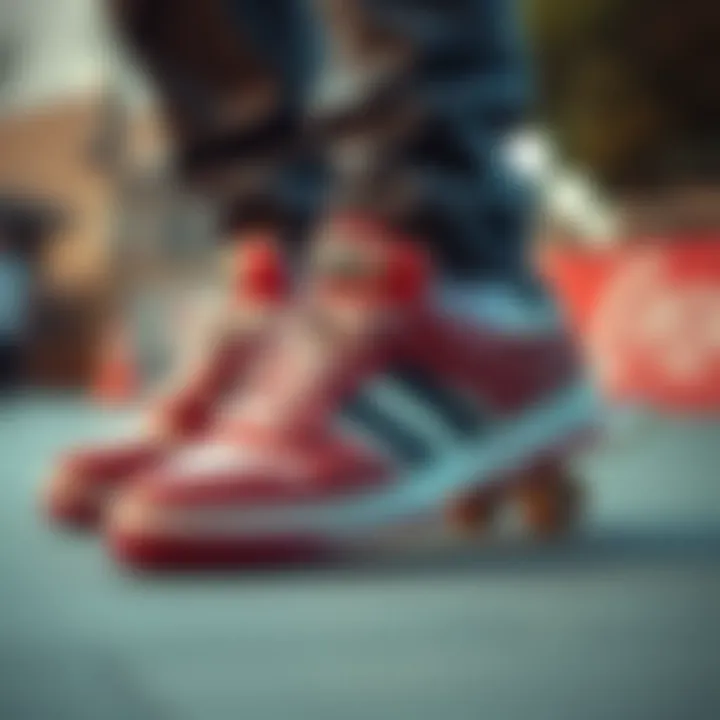
Cultural Contributions Beyond Sneakers
Vans also extends its influence beyond the realm of footwear. The brand sponsors numerous skateboarding events and supports emerging talent, solidifying its role as a cultural promoter. Their collaborations with artists and musicians forge a connection between skate culture and broader artistic expressions.
- Key Feature: Their commitment to community engagement has built an identity that transcends just selling shoes.
- Impact on Skating: Through events and sponsorships, they foster a sense of unity among skaters, encouraging participation and showcasing diverse talent in what often feels like an exclusive corner of the sports world.
Nike SB: Bridging the Gap
Nike SB has carved its niche in the skateboarding market by merging high-performance conditions with the trendiness of mainstream fashion. As a relatively newer player compared to Vans, it has quickly established a significant presence by actively engaging with professional skaters.
Collaborations with Professional Skaters
Nike SB’s strength lies in its collaborations, such as with skaters like Eric Koston and Paul Rodriguez. These partnerships ensure that the shoes cater not just to casual skaters but also to professionals seeking an edge in performance and design. Each collaboration brings unique prints and features that resonate with community expectations.
- Key Characteristic: Tailored footwear that respects the input of seasoned skaters ensures credibility in an often skeptical market.
- Contribution to the Topic: This collaboration makes Nike SB relevant, blending authenticity with high-performance expectations, setting a new standard that influences lesser-known brands.
Even so, some might argue that the focus on famed collaborations could overshadow emerging skaters who aren't as visible yet want to break through the same barriers.
Marketing and Brand Positioning
Nike SB utilizes cutting-edge marketing strategies, often leveraging social media platforms to generate engagement and create buzz around new releases. Their campaigns not only highlight product features but often tell a story that resonates with the skate culture itself.
- Key Feature: Effective storytelling makes their sneaker releases eagerly anticipated events rather than mere products hitting the shelves.
- Impact on the Industry: This focus on narrative creates a cult-like following, where skaters feel a personal connection to the product beyond just its functionality.
In essence, the presence of popular skater sneaker brands like Vans and Nike SB demonstrates the multifaceted relationship between skateboarding and footwear culture. As these brands evolve, the boundaries between skate function, fashion, and culture continue to blur, marking an ongoing journey in the evolution of skater sneakers.
The Intersection of Fashion and Functionality
This section delves into the crucial relationship between fashion and functionality in the realm of skater sneakers, emphasizing how both elements are vital in shaping skateboarding culture. Skater sneakers are not just shoes; they embody a unique blend of style and practical features, creating a synergy that appeals to both skaters and sneaker enthusiasts alike. For skaters, the footwear must withstand the rigors of the sport, providing support and durability during tricks and landing. Meanwhile, the aesthetic appeal cannot be overlooked, as many skaters use their shoes to express individuality and align with various fashion trends.
Sneaker Trends in Skateboarding
Within skater sneakers, trends emerge and evolve, marking shifts in both skate culture and broader fashion circles.
High-Top vs Low-Top: Pros and Cons
High-tops are notable for their added ankle support, making them a favored choice among skaters who prioritize safety during jumps and tricks. The higher cut often helps prevent injuries that come from twisting or rolling ankles. On the flip side, low-tops allow for greater freedom of movement, making it easier for skaters to feel the board beneath their feet. These shoes can also be lighter and less restrictive, giving a better sense of control. Yet, the main drawback of high-tops is their bulkiness, which some skaters feel can hinder certain styles of skating. A skater's choice between high-tops and low-tops boils down to personal preference and skating style, defining not just functionality but also how they want to project themselves within the skating community.
Colorway Variations and Their Influence
The colors and patterns of skate sneakers serve not just a decorative purpose but also reflect trends and personal taste. A bold colorway can signal a skater's personality and stand out in videos or competitions. Brands often release limited edition colorways that become instant hits among collectors, elevating the sneaker's status well beyond mere footwear. However, selecting vibrant or unique colors might limit wearability in various settings. A classic black or white sneaker can blend seamlessly into casual outfits, while an eye-catching design may attract unwanted attention or even detract from other pieces in an ensemble. Understanding the balance between a striking appearance and everyday versatility is key for skaters who wish to merge style and function.
Influence of Skaters on Fashion
Skaters have long influenced fashion trends, becoming icons not just on board but also in style. Their unique looks, characterized by casual and sometimes eccentric attire, have permeated mainstream culture, leading to broader trends and collaborations.
Crossover into Mainstream Culture
The crossover of skate fashion into mainstream culture has opened doors for both independent skaters and major brands. When skaters’ fashion statements gain traction with the general public, it reinforces the creative nature of the skating community. Designers draw inspiration from the skating lifestyle, producing apparel and footwear that blend performance with urban style. However, this blend raises questions about authenticity. Some argue that as skater styles become commodified, they lose the grassroots spirit that initially defined them.
Social Media's Role in Driving Trends
Social media acts as a double-edged sword in the skate community. Platforms such as Instagram and TikTok allow skaters to showcase their tricks and style globally, accelerating trend cycles. Influencers promote particular brands or styles, which can lead to rapid popularity for certain sneakers. This visibility helps smaller brands gain traction but can drown out lesser-known names in the process. Additionally, the effects of social media can create a pressure to constantly keep up with evolving trends, which might not always align with the comfort or functionality that skaters seek. The challenge remains in navigating these digital landscapes while staying true to one’s origin and passion for skating.
Sustainability in Sneaker Production
In today’s world, the sustainability of any product is a hot topic. Sneaker production is no exception, especially in the skater sneaker community. Skaters want sneakers that don’t just perform well on their boards but also respect the environment. This section dives deep into how eco-friendly practices are becoming more critical in sneaker manufacturing and how these changes benefit both the planet and the culture surrounding skateboarding.
Eco-Friendly Materials
Recycled Components
Recycled materials in sneakers can make a real difference. The concept is straightforward: using materials that would otherwise be wasted helps reduce the overall environmental footprint of sneaker production. Popular recycled components, like plastic bottles or tires, can be repurposed into sneakers, decreasing waste and resource consumption. Many brands are adopting this approach because it sends a strong message to environmentally conscious consumers.
However, it's not all sunshine and rainbows. While the use of recycled components is beneficial, producers must ensure that these materials meet performance standards. There's always the risk that recycled materials might compromise the durability or comfort of the shoes. Still, when done correctly, sneakers made with recycled components can tick both boxes:
- Sustainability
- Performance
Brands like Adidas are paving the way, showcasing how recycled materials can fit into high-performance skater sneakers.
Biodegradable Alternatives
Another promising direction in sneaker production is the development of biodegradable alternatives. Unlike traditional materials, which can take hundreds of years to decompose, these alternatives can break down in a shorter timeframe when disposed of properly. For instance, materials derived from plants, like algae, are being used for sneaker uppers and soles. The idea is compelling—once these sneakers hit their end-of-life, they won't sit in a landfill forever.
Biodegradable materials not only appeal to eco-conscious consumers but also allow brands to market their products as more sustainable. However, there’s a catch: the durability of these materials can sometimes be a concern. While they may break down in an environmentally friendly way, they need to withstand the daily wear and tear that comes with skateboarding.
Ethical Manufacturing Practices
Transparency in Sourcing
Transparency in sourcing is becoming increasingly vital in the sneaker industry. Consumers are more educated than ever, prompting brands to reveal where their materials come from and under what conditions they are produced. This practice fosters trust and loyalty among skaters, who often value brands that hold themselves accountable.
When a brand openly shares its sourcing practices, it can enhance its reputation within the community. Buyers are looking for assurance that the sneakers they wear are ethically produced. However, this isn't just about marketability; transparency also encourages brands to improve their practices. When consumers can see the specifics of how a sneaker is made, brands are under pressure to maintain high ethical standards. But, remaining completely transparent is no small feat. Gathering such information can be resource-intensive, especially for larger companies.
Labor Practices in the Industry
The impact of labor practices in the sneaker industry cannot be overlooked. As brands strive to make their products more sustainable, ensuring fair labor practices is crucial. This includes fair wages, safe working conditions, and respect for workers' rights. For skaters, knowing that their footwear is produced without exploitation can heavily influence their purchasing decisions.
While many brands are making strides toward improving these practices, there are still significant challenges to overcome. Some companies might follow surface-level ethics while ignoring deeper issues in their supply chain. The challenge lies in balancing the cost of ethically made sneakers with the price that consumers are willing to pay. Brands need to find a sweet spot that honors sustainability and practicality without compromising the culture and passion of skateboarding.
Community and Collaboration
Skateboarding is not just a sport; it's a culture that thrives on community and collaboration. Within this vibrant ecosystem, skater sneakers have become a critical medium of expression and connection among enthusiasts. These shoes do more than just provide grip and comfort; they symbolize a shared identity and passion. The community aspect nurtures a sense of belonging among skaters, which transcends mere participation. This is where collaborative ventures between skaters and brands come into play, significantly shaping the landscape of skateboard footwear.
Skater-Owned Brands
Significance in the Skateboard Community
Skater-owned brands hold a unique place in the shoe landscape, offering authentic products born from true skate culture. They provide a window into the creativity and innovation that skaters are capable of. These brands don’t just sell shoes; they represent a lifestyle. A skater-owned brand often creates a bond of trust within the community. For instance, brands like Alien Workshop or Baker Skateboards embody values that resonate deeply with skaters. The advantages of this approach are numerous:
- Authenticity: Products that are designed by skaters for skaters often meet the actual needs of the community.
- Connection: Consumers feel more connected to these brands, knowing the products are created by someone who understands their lifestyle.
However, with the rise of corporate interest in skateboarding culture, some of these brands face challenges. Maintaining that purity while competing against larger entities can be tricky. The unique feature here is that personal narratives are stitched into every single pair of shoes they create.
Impact on Brand Loyalty
The impact of skater-owned brands on loyalty can't be overstated. When skaters support a brand founded by their peers, it creates a profound sense of loyalty that often surpasses market trends. This loyalty isn't birthed merely from advertising but from shared experiences, values, and history. For example, many skaters will choose to ride for a shoe brand not because of its commercial success but due to its association with iconic skaters. This can lead to:
- Sustained Advocacy: Skaters promoting their favorite brands create an organic growth model for these companies.
- Community Events: Many skater-owned brands engage in local events or sponsorships, further solidifying their position within the community.
That being said, there are challenges such as the potential for brand dilution when expanding. A brand that once catered to an insider audience risks alienating its base when it broadens its reach.
Collaborative Sneaker Lines
Limited Editions and Collector's Items
Collaborative sneaker lines are often hyped as limited editions, creating a blend of excitement and exclusivity. When a well-known skater collaborates with a brand, the resulting shoe often embodies a unique blend of innovation and classic design. These items usually capture an essence that resonates deeply with collectors. The key characteristic here is the rarity of these sneakers. For example, the collaboration between Nike SB and various professional skaters has resulted in shoes that quickly became sought after collectibles.
- Scarcity: The limited number of these designs increases their value on the resale market.
- Dialect of the Community: Each limited release tells a story, reinforcing bonds within the skate community.
However, the hype surrounding limited editions can also lead to a challenging situation for average skaters; not everyone can snag a pair, which might breed frustration.
Cultural Significance of Collaborations
Collaborative sneaker lines also have rich cultural significance, acting as a bridge between diverse communities. They foster relations between skateboarding and other realms like art and music. When skaters collaborate with graphic designers or other creatives, the resulting product transcends basic functionality and becomes a piece of art. The alliances formed in these collaborations are crucial:
- Mutual Growth: The collaboration brings benefits to both the brand and the skater, involving creativity from multiple angles.
- Cross-Pollination: Brands can attract a wider audience through these unique designs and associations.
However, navigating these collaborations can sometimes feel like a tightrope walk. When the collaboration becomes more about commercial gain than artistic integrity, the product risks losing its initial spirit.
"Skater sneakers today are not just for skating; they are a statement of community, artistry, and resilience."
In essence, community and collaboration come together to enrich skater sneakers' evolution, highlighting their importance in both skateboarding culture and sneaker history.







